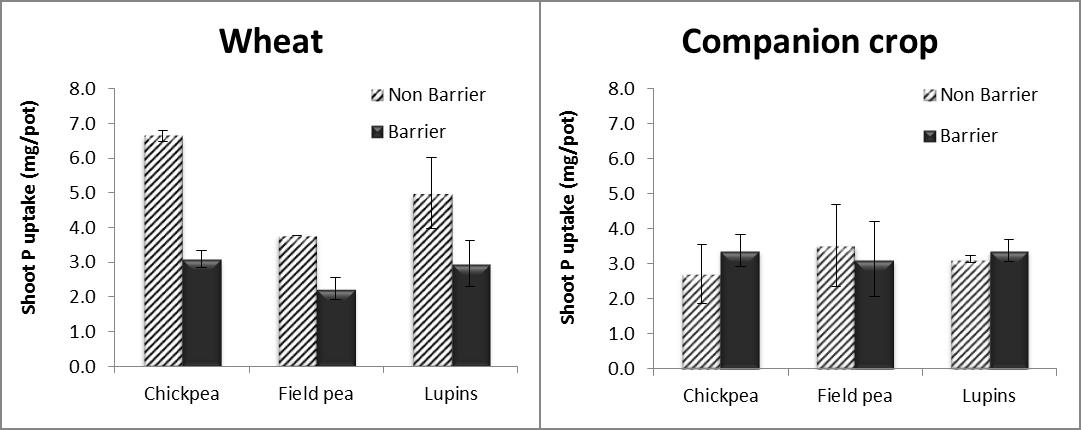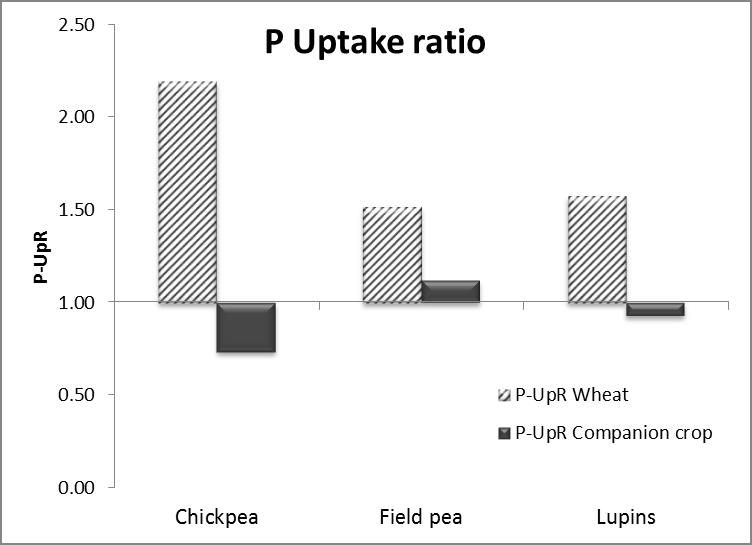Role of legume break crops in mobilising soil phosphorus (P) for wheat
Author: Daniel Espinosa | Date: 05 Feb 2014
Daniel Espinosa,
Department of Agricultural Sciences, La Trobe University
Take home messages
- Legume break crops can significantly increase the P uptake of intercropped wheat.
- The legumes differ in their ability to mobilize soil P reserves.
- Interactions between soil properties, plant biology and microbial activity are likely to determine the amount of soil P that is mobilised by the legume.
Background
A limited number of studies have demonstrated that wheat following a pulse break crop takes up more P than wheat following wheat, over and above any nitrogen or disease break benefits (Nuruzzaman et al. 2005; Hassan et al. 2012). The mechanisms for this enhanced P uptake by the following wheat are not well understood. Research evidence suggests that the mobilization of P by the legume crop occurs from sparingly soil P compounds that wheat cannot use. Extra P is then likely to become available from the decomposition of the legume crop residues. It is also possible that changes in soil microbial communities with legume crops occur, which may enhance soil P availability for the wheat crop (Alamgir et al. 2012) .
Legume crops have different strategies to mobilize P from the soil. Acidifying the soil around the roots, and organic acid release from roots, are among those strategies that make legumes efficient in mobilizing P from inorganic soil P pools (Hinsinger 2001; Hinsinger et al. 2005). Soil acidification is particularly important to dissolve P from calcium carbonates, whereas organic acids will chelate cations like Fe+3, Al+3 and Ca+2 to release the P. However, it has been difficult to detect any surplus P in the soil after a legume break crop. It is likely that any additional P that is mobilized by the break crop is “re-fixed” by the soil or immobilized by microbial activity. In view of these difficulties, I developed an alternative intercropping approach to see if wheat plants, growing together with legume crops, could take up extra P compared to wheat plants growing in the absence of legume roots.
The research that I will undertake in my PhD program aims to understand how legume break crops can mobilise P for the following wheat crop. Such understanding may well lead to practices that can help grain producers use more of the P “bank” in cropping soils, that is currently unavailable to cereal crops.
Preliminary Results
A glasshouse study was initially undertaken to compare the ability of different break crops to mobilise soil P and increase the P uptake of companion wheat plants. We proposed that surplus mobilised P, resulting from the root activity of the companion break crop, would be scavenged and taken up by the inter-mingled wheat roots. The experimental system involved wheat and different break crops growing together, or growing separately with a physical barrier preventing the intermingling of their roots.
The companion plants of chickpea, white lupins and field pea significantly increased P uptake by wheat (Figure 1) when the roots of both the wheat and the pulse were grown together, compared to when the wheat roots grew separated from those of the legume crop. The P uptake was increased by 114% and 70% by chickpea and white lupins, respectively, due to an increase in both shoot biomass and higher P concentrations in the wheat shoots. Wheat growing with field pea had the lowest shoot dry biomass overall. However, the P uptake of the wheat shoots still increased by 69%, despite reduced wheat growth with the barrier in place.

Figure 1. Phosphorus uptake by wheat and companion legume break crop under two systems, with and without barrier. Error bars represent one standard error.
An alternative way to assess the effect of the companion plants on P uptake by wheat is to calculate the P uptake ratio (P-UpR) between the no-barrier and the barrier systems (Figure 2). The greatest increase in P uptake by wheat (2.19 wheat P-UpR) occurred with chickpea as a companion plant. However, the P uptake by chickpea was reduced by the wheat (0.74 chickpea P-UpR). White lupins and field pea also increased wheat P uptake (1.58 and 1.52 P-UpRs, respectively) while the P uptake by these legumes was not affected by wheat (0.93 and 1.12 P-UpR, respectively, for white lupins and field peas).

Figure 2. Phosphorus uptake ratio between the two systems: with and without barrier.
This initial study highlights how legume break crops differ in their ability to mobilise P from the Vertosol soil. Wheat plants were able to scavenge and utilize this extra mobilised P when grown as companion crops (i.e. intermingled roots) with legume break crops. Further experiments will follow this study. I will be particularly focussed on understanding the mechanisms by which common legume break crops mobilise soil P, so that the process can be exploited in the cropping system.
Acknowledgments
I wish to thank my supervising panel for their guidance and the Grains Research and Development Corporation (GRDC) for their financial support through the Soil Biology Initiative project (UA00119).
References
Alamgir, M., A. McNeill, C. X. Tang and P. Marschner, 2012: Changes in soil P pools during legume residue decomposition. Soil Biol Biochem 49, 70-77.
Hassan, H. M., P. Marschner, A. McNeill and C. Tang, 2012: Grain legume pre-crops and their residues affect the growth, P uptake and size of P pools in the rhizosphere of the following wheat. Biol Fertil Soils.
Hinsinger, P., 2001: Bioavailability of soil inorganic P in the rhizosphere as affected by root-induced chemical changes: a review. Plant and Soil 237, 173-195.
Hinsinger, P., G. R. Gobran, P. J. Gregory and W. W. Wenzel, 2005: Rhizosphere geometry and heterogeneity arising from root-mediated physical and chemical processes. New Phytologist 168, 293-303.
Nuruzzaman, M., H. Lambers, M. D. A. Bolland and E. J. Veneklaas, 2005: Phosphorus benefits of different legume crops to subsequent wheat grown in different soils of Western Australia. Plant and Soil 271, 175-187.
Contact details
Daniel Espinosa
Agricultural Sciences La Trobe University, AgriBio – Centre for AgriBioSciences
5 Ring Rd, Bundoora, VIC 3083, Australia
61(03)9032-7462
GRDC Project Code: UA00119,
Was this page helpful?
YOUR FEEDBACK
